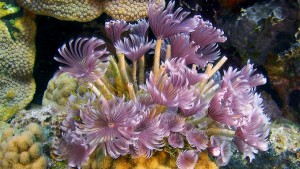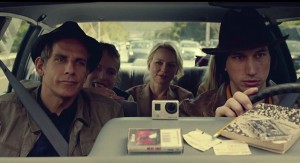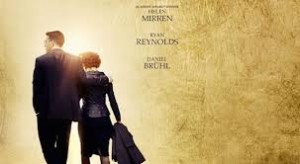Interview: Jean-Michel Cousteau of “Secret Ocean 3D”
Posted on April 2, 2015 at 3:51 pm

Jean-Michel Cousteau has carried on the legacy of his famous father, Jacques Cousteau, who first allowed the world to see the creatures that live in the water, through deep-sea diving and his pioneering underwater photography. Now his son has used the latest technology to show us another world previously unseen, with tiny animals and colors as bright as any garden in full flower.
I spoke to Cousteau about his latest film, Secret Ocean 3D.
He wanted to work with IMAX 3D, in order “see the behavior of things that I’m flying or swimming over all the time since I started diving when I was seven years old, fifty nine years ago. And I would be very frustrated not to be able to see the behavior of tiny little things. So they put together the prototype cameras which are allowing us now to focus in slow motion on the behavior of small creatures and see what they are doing to feed themselves, protect themselves and be of course in relationship with other creatures. So for me I am now for the first time in my life able to see things on the big screen which I cannot see when I’m under water.”
I was especially fascinated with the tiny animals who look like flowers and the squid who could instantly change color to match the environment. “The flower-like creatures are found mostly in the tropical environment. The beautiful one that you see in the show are in the tropics in the Caribbean and in Fiji. Then there were these beautiful worms which are called Christmas tree worms. The squids were in Southern California. Squids and octopus can change their color, their texture. They have no bones so they are very bendable. They can hide. They are really amazing creatures. The bad news as you probably have heard on the show is that they die every year. After they reproduce they are gone. I am totally convinced that if they didn’t die they probably would run the planet today because they have real brains and are very clever creatures.”
There is a creature that looks like a pile of sticks. In the film, we learn that it has no head or brain but can regenerate its limbs. “We have seen those creatures but usually we don’t see the same one during the day and then come back and see the same one at night. Thanks to science and scientists we are able to learn about these creatures because they capture them and they analyze them. So the instinct that they have to capture food and bring into their mouth when you realize they have no brain is just for me it’s fascinating. I’m just like a kid every time I see them. So we were very patient, we saw it. As a matter of fact we saw two of them during the daytime and we decided, okay we have to wait and come back at night and we did and they were still there. And we were able to film them.”
What surprised me most in the film was the information about the tiniest creatures, plankton, and the part they play in keeping the rest of the world breathing. “Plankton are really the foundation of life in the ocean. And you have two kinds of planktons, the big which you see which are very spectacular, many different types of species and then the tiny little ones which drift. And the big ones are animals. They are called zooplankton. And then the tiny little ones which are plants, they are phytoplankton. Now the zooplankton is feeding on the phytoplankton. They need that to feed themselves and to grow and they are what you call the foundation of all life in the ocean. Without them there would be no life. So being absorbed within the food chain, they migrate towards the surface every day. And they are very very active at night and of course there are a lot of creatures that are coming by and feeding on them, both the plants and animals. And it goes all the way up the food chain all the way to the big creatures whether they are fish or mammals, whales or sea lions or tuna. Totally every creature is dependent on these unbelievable plants and animals which are the foundation of all life in the ocean. As a result of all that about half of the oxygen that is being produced comes from the ocean. And every other breath of air that you take you are getting it thanks to the ocean. So we are totally connected and dependent on the quality of life in the ocean. Unfortunately we didn’t know that before. Now we are learning and we are learning very fast thanks to what I call communication evolution. There are people all over the planet now who are asking questions now about these creatures. We need to learn very quickly and pass on the information to the decision-makers and the future decisions makers which are the children, the young people. They need to understand that we need to stop using the ocean as a garbage can. Because all of that decomposes and it affects the food chain, it affects the plankton, it affects the creatures which are concentrating those chemicals in their system and accumulates them, and concentrates as the creatures are getting bigger and bigger up the food chain. So we are hurting that environment which means we are hurting ourselves. At the end of the day it is not just the fact that we fishing or we catching more than nature can produce. We have learned that a long time ago, we are not hunters and gatherers we are farmers. So we need to do something with the ocean but we cannot farm creatures that are disappearing and you cannot farm in the ocean where you have the storms, hurricanes and so on.”
Jean-Michel told me that his father pushed him into the water with a tank on his back when he was seven and the water is home to him. “He kept telling me, ‘People protect what they love,’ and I kept telling him, ‘How can you protect what you don’t understand?’ So thanks to my dad I have this thirst for discoveries and wanting to protect what we don’t understand.”




